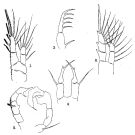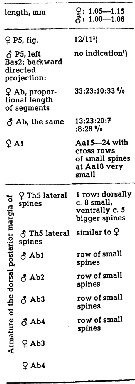|
|
 |
Fiche d'espèce de Copépode |
|
|
Calanoida ( Ordre ) |
|
|
|
Diaptomoidea ( Superfamille ) |
|
|
|
Acartiidae ( Famille ) |
|
|
|
Acartia ( Genre ) |
|
|
|
Acanthacartia ( Sous-Genre ) |
|
|
| |
Acartia (Acanthacartia) chilkaensis Sewell, 1919 (F,M) | |
| | | | | | | Syn.: | Acartia chilkaensis sittangi : Steuer, 1934 | | | | Ref.: | | | Sewell, 1919 (p.9, figs.F,M); 1924 (p.790, Rem.) 1932 (p.395); Kasturirangan, 1963 (p.64, figs.F,M); Wellershaus, 1969 (p.269: figs.F,M, p.272: Rem.F,M); Abraham, 1970 (p.52, Rem.); 1976 (p.80, Rem.); Silas, 1972 (p.650); Barthélémy, 1999 a (p.9, Fig.23, C, D); 1999 (p.861, Fig.4, C, D) |  issued from : R.B.S. Sewell in Rec. Indian Mus., (1918) 1919, XYI. [Pl.IX, Figs.1-5]. Female (from Chilka Lake): 1, P1; 2, P2 to P4; 3, Mxp; 4, P5. Nota: Head and 1st thoracic segment separate, 4th and 5th fused. Postreior thoracic margin rounded and armed with a series of small spines. 1st and 2nd abdominal segments armed on the dorsal part of the posterior margin with a row of minute spinules. Proportional lengths of urosomites and furca 39:19:17:25 = 100. A1 19-segmented (segments 2-6, 8-10, fused); segments 16, 17, and 19 all armed with a transverse row of minute spines on the distal part of the posterior margin. P5 resembles those of A. centrura. Male: 5, P5. Nota: Proportional length of cephalothorax and abdomen 75:25. Proportional lengths of urosomites and furca 10:31:20:6:14:19 = 100. The abdominal segments are all devoid of spines (except from Cochin's specimens with the abdominal segments 2, 3 and 4 all bearing a row of minute spines on the posterior margin dorsally).
|
 Issued from : S. Wellershaus in Veröff. Inst. Meeresforsch. Bremerh., 1969, 11 (2). [p.269, Fig.64-65]. After Sewell, 1919. Female: 65, P5. Male: 64, P5.
|
 Issued from : S. Wellershaus in Veröff. Inst. Meeresforsch. Bremerh., 1969, 11 (2). [p.269, Fig.68-69]. As Acartia (Acanthacartia) chilkaensis sittangi. After Steuer, 1934. Female: 68, P5. Male: 69, P5.
|
 issued from : R.-M. Bathélémy in J. Mar. Biol. Ass. U.K., 1999, 79. [p.861, Fig.4, C-D]. Acartia chilkaensis sittangi. Scanning electon miccrograph. Female (from Sittang River, near Matlab, Burma): C, genital double-somite (ventral); D, detail of the left genital slit. Scale bars: 0.030 mm (C); 0.005 mm (D). Symbols: gs = genital slit; arrowhead = lamellar flap.
|
 Issued from : S. Wellershaus in Veröf. Inst. Meeresf. Bremerhaven, 1969, XI. [p. 272, Table 3]. List of characters in Acartia chilkaensis Sewell, 1919 (from Chilka Lake). 1): according to the figures in the original descriptions.
|
 Issued from : S. Wellershaus in Veröf. Inst. Meeresf. Bremerhaven, 1969, XI. [p. 272, Table 3]. List of characters in Acartia chilkaensis sittangi Steuer, 1934 (from Burma). 1): according to the figures in the original descriptions.
| | | | | Ref. compl.: | | | Sewell, 1948 (p.324, 430); Subbaraju & Krishnamurphy, 1972 (p.25, 26 ); Madhupratap & Haridas, 1986 (p.105, tab.2); Gouda & Panigrahy, 1995 (p.206); Rakhesh & al., 2008 (p.154, abundance vs stations); Rakhesh & al., 2013 (p.7, Table 1, abundance vs stations). | | | | NZ: | 1 | | |
|
Carte de distribution de Acartia (Acanthacartia) chilkaensis par zones géographiques
|
| | | | | | | Loc: | | | E India (Rushikulya estuary, Godavari estuary, Porto Novo, Kakinada Bay, Chilka Lake, Salt Lakes), ? Cochin, Burma (Sittang).
Species type: India (Chilka Lake). | | | | N: | 8 | | | | Lg.: | | | (83) F: 0,75; M: 0,7; {F: 0,75; M: 0,70} | | | | Rem.: | ± saumâtre (principalement en eau douce), estuaires
.
Acartia chilkaensis sittangi Steuer,1934 (F,M)
Ref.: Steuer, 1934 (p.336,figs.F,M); Wellershaus, 1969 (p.269: figs.F,M, p.272: Rem.F,M); Abraham, 1976 (p.80, Rem.); Barthélémy, 1999 (p.857, 864, figs.F)
Loc.: Birmanie (Sittang Riv.)
Lg.: (192) F: 1,15-1,06; M: 1,06-1; {F: 1,06-1,15; M: 1,0-1,06} | | | Dernière mise à jour : 16/12/2021 | |
|
|
 Toute utilisation de ce site pour une publication sera mentionnée avec la référence suivante : Toute utilisation de ce site pour une publication sera mentionnée avec la référence suivante :
Razouls C., Desreumaux N., Kouwenberg J. et de Bovée F., 2005-2025. - Biodiversité des Copépodes planctoniques marins (morphologie, répartition géographique et données biologiques). Sorbonne Université, CNRS. Disponible sur http://copepodes.obs-banyuls.fr [Accédé le 17 décembre 2025] © copyright 2005-2025 Sorbonne Université, CNRS
|
|
 |
 |









